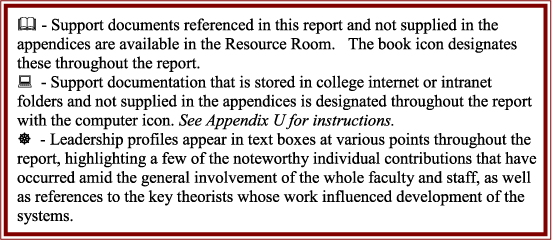

Summary of Responses to Identified HLC Concerns
1. Involvement of employees, at all levels within the
organization, in the plan's development, implementation, and
evaluation.
There are numerous opportunities for staff from all levels and all
areas of the College to be actively involved in strategic planning,
including serving on committees and conducting the departmental
activities listed on departmental operational plans. Further, area
facilitators serve as informational conduits for information
between OPIC and staff.
2. Indications of the following key
elements in the college's strategic plan: staff responsible,
budgetary implications, evaluation, and probable timelines for
implementation.
The committee charges establish committee responsibilities, and the
co-chairs facilitate the committee's work. The planning cycle
consolidates the timelines for completing committee work.
Operational planning is conducted for a single year, and the
template includes identification of the person responsible for the
completion of the activity. Committees are encouraged to evaluate
their progress throughout the year and recommend changes. Year-end
operational plan reports provide the opportunity to evaluate
progress toward objectives and to carry over uncompleted projects
to the next year. The planning cycle is timed to feed into the
budgeting process, and the annual budget recommendation memo to the
Board of Trustees ties specific dollars budgeted to goals and
objectives.
3. Linkage to the college's stated
mission and goals.
As a part of its responsibilities, OPIC reviews activities and
accomplishments in light of the mission and strategic goals and
objectives and considers recommendations that impact budgeting for
their congruence with the mission and goals. Each activity
identified in departmental operational plans is linked to specific
goals and objectives. Finally, committees are increasingly
identifying the mission, goals and objectives as the basis for
their work.
4. Department and individual
administrative goals that flow from those of the strategic plan and
assume responsibility for appropriate parts of that
plan.
The mission and goals are kept visible for all staff to remain
aware of them. Departmental operational plans are linked directly
to strategic goals and objectives and assign responsibility to
specific individuals.
5. A method for assessing progress
throughout the time designated for action and for summarizing
actions upon completion.
Program review recommended actions are assigned to individuals and
given a timeline for completion in the operational plan.
Operational plan annual reports describe progress toward meeting
goals, and individual administrators monitor progress throughout
the year. Committees report their progress and activities through
OPIC, and summary reports are prepared by committees for the
operational plan and presented to OPIC. OPIC reviews activities and
accomplishments in light of the mission and strategic goals and
objectives.
6. Linkages from the institutional
strategic plan with other departmental plans.
The program review is linked to the strategic plan and includes a
review of how the program's mission links with the College's
mission. Departmental operational plans flow from the strategic
plan as each planned activity is linked directly to one or more
strategic goals.
7. Clear and direct involvement from the
Board of Trustees in establishing the college's mission and
vision.
The Board of Trustees developed the College's vision statement,
with input from SVCC employees. All revisions in the College's
mission, values, philosophies, and strategic goals and objectives
are presented to the Board of Trustees. The President keeps the
Board informed of developments in all areas throughout the
College.
8. An institutionally communicated and
supported mission.
The mission drives the College's decisions and plans.
The SVCC values, philosophies and strategic goals appear with the
mission on a document which is distributed widely.








